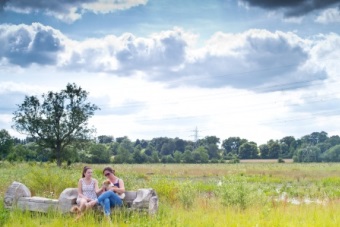Visiting Diamond Wood

Diamond Wood is open to everyone and attracts many visitors throughout the year. Although still in its relative infancy, there is already a diversity of tree, plant and insect species to explore.
The two separate woodland sites that make up the Diamond Wood are connected via public footpaths through Sutton Bonington village. A permissive footpath links Pasture Lane to the River Soar Public Right of Way (see map of the area  ).
).
Pasture Lane showcases sculptures and seating created by local sculptor Errol Morris from trees felled on University Park. It also contains activity and recreation areas, with plans for an outdoor gym to be installed.
Interpretation boards provide a guide to the species of plants and animals that can be spotted at Pasture Lane, enabling visitors to get the most from their visit.
A lasting legacy
Diamond Wood was designed to be a recreational and educational facility for the whole community and is part of a bigger vision to create productive landscapes where wildlife and people flourish.
The Pasture Lane site contains over 22,000 trees, which were planted with the help of staff and pupils from Sutton Bonington Primary School, Friends of Sutton Bonington group, and staff and students from the University.
It is made up of distinct habitat areas, including:
- Native woodland - such as English Oak, Field Maple, Hawthorn, Rowan and Downy Birch
- Wet woodland - provides vital cover and breeding ground for mammals such as otters; it also supports numerous bat species and rare birds
- Alder, willow and shrub areas
- Specimen trees
- Wildlife pond
- Focused teaching area
It is early days for the Pasture Lane woodland but the pond is establishing well, as are the flowering plants sown to create ground level interest and cover to encourage a wide variety of different animal and insect species throughout the year.
The Soar Lane site is a mix of native woodland, willow crops and wild flower meadows. The willows, already over 2m tall, form part of a research project looking at the impact of coppicing cycles on productivity. Butterflies are particularly noticeable at Soar Lane during the summer.